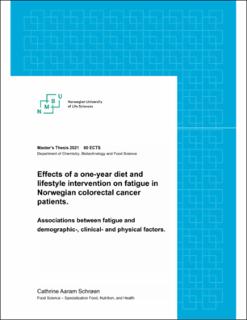| dc.description.abstract | Objective: Cancer related fatigue is a common symptom during or after cancer treatment. The aim of the current study was to test if a one-year dietary intervention improved the degree of fatigue after cancer treatment in a Norwegian CRC population. We also examined how various variables are associated with the fatigue levels before the start of the intervention.
Subjects and methods: The study was conducted in a subpopulation (n=322, aged 50-80 years, the female to male ratio was 151/171) of the CRC-NORDIET study, which is a randomized controlled trial designed to investigate the effects of a one year diet- and lifestyle intervention, comparing a control group to an intervention group that received a dietary intervention program based on the Norwegian food-based dietary guidelines. Both groups received advice on physical activity. A Chalder fatigue questionnaire was used to register the degree of total fatigue (TF) and the subscales: physical (PF) and mental fatigue (MF). Measures of physical performance and physical activity were recorded at each visit (baseline, 6 months and one year) along with other various demographic and clinical data. PG-SGA was used to assess nutritional status.
Results: A trend for an effect of the intervention on change in TF scores (p=0.076) was found, and more patients improved in fatigue status in the intervention group as compared with the control group. In the intervention group TF improved in 65.6% compared to 52.3% in the control group (p=0.021). A similar trend was found for PF whereas MF status was not affected differently. Being a woman increased the odds of having TF of OR = 1.87 at baseline. The youngest age group had a 3 point higher median TF compared to the oldest age group at baseline. A 7 point higher median TF score was found among those that were on sick leave compared to those who were working. TF scores were associated with PG-SGA scores (rho=0.4, p<0.001), indicating increased fatigue with worse nutritional status, and were negatively associated with muscle mass. A 4 point higher median TF was seen in the group having adjuvant treatment (chemotherapy), compared to those who had not Weak associations were also found for performance measures and severity of the cancer (TNM stage). For most variables no or little degree of association was found for MF.
Conclusion: The results indicate that a diet and lifestyle intervention may reduce the frequency of patients having fatigue after CRC surgery and that sex, age, ability to work, nutrition status and muscle mass are associated with the fatigue burden at baseline. Finally, the physical aspects of fatigue seem to be a larger problem than mental fatigue in the CRC-NORDIET population. | en_US |

